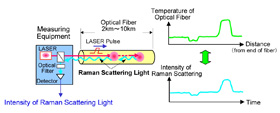Archived content
NOTE: this is an archived page and the content is likely to be out of date.
Fujitsu Develops Technology Enabling Real-time Multiple-Point Temperature Measurement
-Helps reduce energy consumption in large data centers by creating greater visibility of temperature distribution-
Fujitsu Laboratories Ltd.
-
[1] Green Policy Innovation
A global project by Fujitsu to help its customers reduce their environmental footprint. Fujitsu aims to achieve a cumulative reduction of more than 7 million tons of CO2 in four years, from fiscal 2007 through fiscal 2010. Under this initiative, Fujitsu will concentrate its know-how and technological resources in two areas: reducing the environmental burden of IT infrastructure, and reducing customers' environmental burden through new IT applications.
-
[2] Thermocouples temperature sensors
A temperature sensor consisting of two wires of different metals, joined together. This creates an electrical potential at the junction that is proportionate to the temperature, which can be used to measure temperature.
-
[3] Raman scattering light
A minor scattering effect of light in the long and short wavelengths resulting from an intense light, such as a laser, incident on a substance. One of the characteristics of the Raman scattering light is that its intensity varies with the temperature of the substance.
-
[4] Position resolution
This refers to the ability to simulate temperature accurately, and is the minimum distance required to assess differing temperature between two points of measurement that are near to each other. A high position resolution means that the minimum distance required between two points to differentiate their temperature is close.
About Fujitsu Laboratories
Founded in 1968 as a wholly owned subsidiary of Fujitsu Limited, Fujitsu Laboratories Limited is one of the premier research centers in the world. With a global network of laboratories in Japan, China, the United States and Europe, the organization conducts a wide range of basic and applied research in the areas of Multimedia, Personal Systems, Networks, Peripherals, Advanced Materials and Electronic Devices. For more information, please see:http://jp.fujitsu.com/group/labs/en/
Technical Contacts
Environmental Technology Lab.Device and Materials Lab.
![]() Phone: +81-46-250-8257
Phone: +81-46-250-8257
![]() E-mail: eco_mat@ml.labs.fujitsu.com
E-mail: eco_mat@ml.labs.fujitsu.com
Company:Fujitsu Laboratories Ltd.
Company or product names referenced herein are trademarks or registered trademarks of their respective owners. Information provided in this press release is accurate at time of publication and is subject to change without advance notice.
Date: 04 April, 2008
City: Kawasaki, Japan
Company:
Fujitsu Laboratories Ltd.,
,
,
,
,

